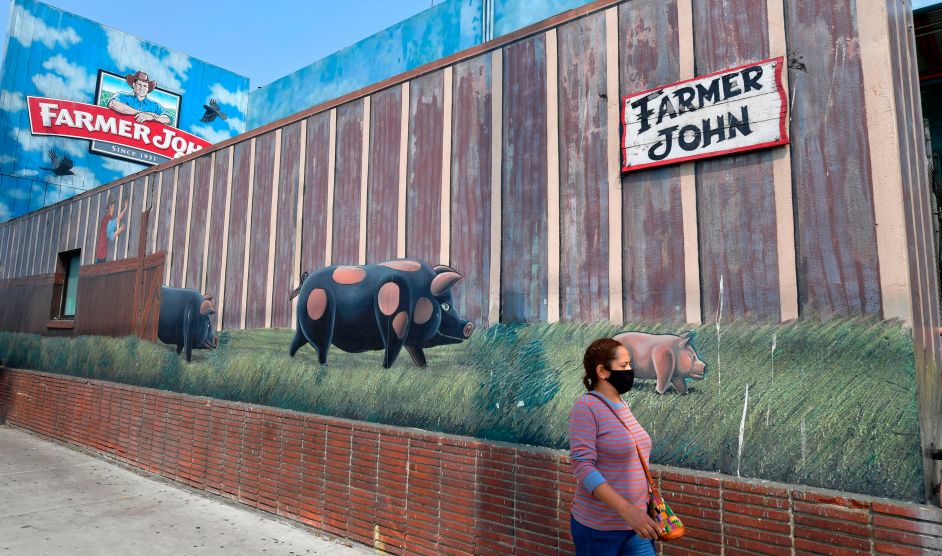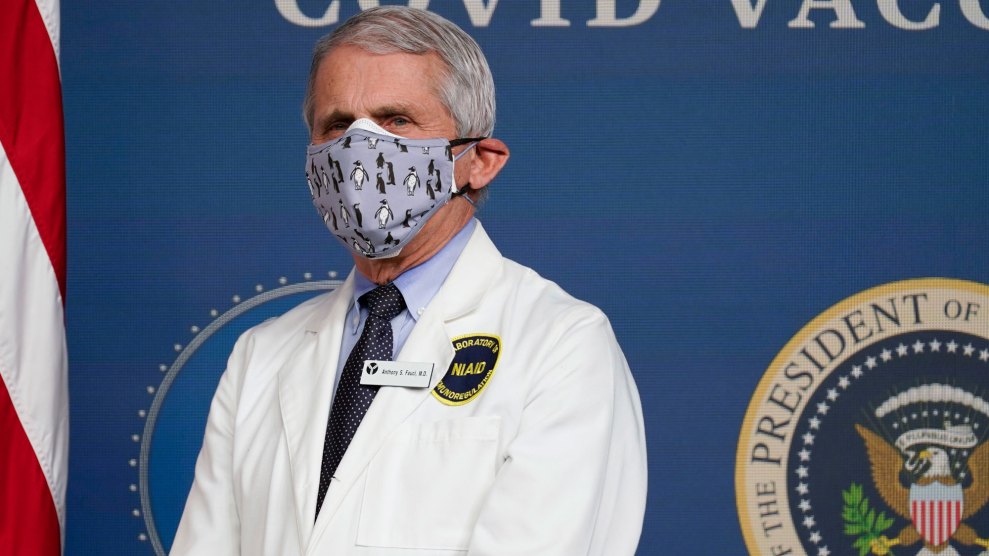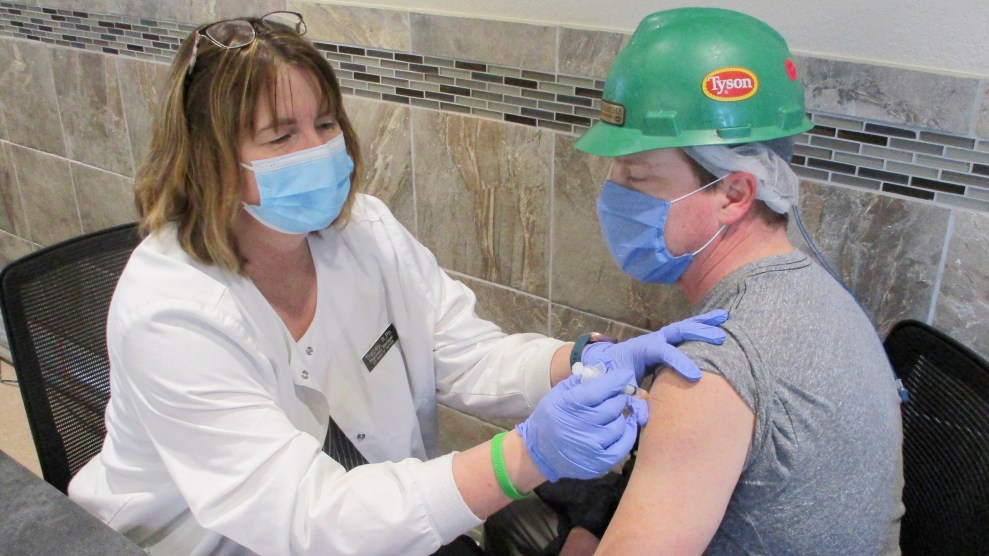
A woman wears a facemask while walking past the Farmer John Slaughterhouse in Los Angeles.Frederic J. Brown/Getty
This story was originally published by the Food and Environment Reporting Network.
A coronavirus outbreak at the Farmer John pork processing plant in Los Angeles County began nearly a year ago. But it never went away. In recent months, as the county has become a COVID-19 epicenter, in part driven by outbreaks at manufacturing facilities, the cases at the Smithfield Foods-owned plant have more than doubled—with more than 300 cases reported in January alone.
The Vernon plant has been the focus of two state investigations and was cited in November for violations related to how it handled the outbreak last year. The workplace safety investigation found that the plant failed to adequately train workers or report virus-related data to public officials.
Internal county and city health department emails, obtained by the Documenting COVID-19 project in collaboration with the Food and Environment Reporting Network (FERN), further reveal that the plant inconsistently reported cases to local officials and violated a state public health protocol even as the California investigation was underway.
Currently, 784 workers at the plant have tested positive for COVID-19, including the new infections in January, according to county health department data. The total amounts to nearly half of the plant’s workforce. Five have died. It is the largest outbreak at any food-processing facility or other similar worksite in Los Angeles, according to the county public health department, and one of the largest meatpacking plant outbreaks in the country.
The spike in recent infections since the November citation prompted state safety regulators to reopen an investigation at the plant in December. With California’s adoption late last year of more rigorous workplace safety standards, experts and labor advocates say more should be done to protect workers at Farmer John and other meatpacking facilities where the virus continues to spread. That includes vaccinating food-manufacturing workers, who became eligible to receive the COVID-19 vaccine in Los Angeles County on March 1.
Given the more rigorous state standards, the facility should also be inspected again in person, “ideally without notice,” to “determine whether there are any repeat violations that would now fall under the scope,” said Mara Ortenburger, director of communication and research at Worksafe, a worker safety advocacy group in Oakland, California. “This is an incredible emergency. Workers are dying and their families are impacted.”
In February 2020, when the Farmer John outbreak began, the plant was reporting worker cases to city officials, as well as to the county health department. Health officials use this data to pinpoint outbreaks and determine whether additional measures need to be taken to curtail the spread of the disease.
But on May 6, Fredrick Agyin, director of the health and environmental control department for the city of Vernon, wrote to Greg Hernandez, the plant manager, saying: “Our office will no longer require Smithfield to submit the confirmed COVID-19 positive cases to us.” Agyin says that at the time, he was focused on helping the company get worker testing protocols in place. “Our point was really to pivot to how do we help them to stay open,” he says.
In his May email, Agyin referenced then-President Trump’s April executive order on the meat supply chain, which, he wrote, “mandate[s] meat processing plants to stay open to maintain the continuity of the nation’s food supply.” However, the order did not directly require plants to continue operating but only authorized the Secretary of Agriculture to “take all appropriate action…to ensure that meat and poultry processors continue operations.” Agyin denies that he told the plant to stop reporting worker cases because of the executive order.
Yet Agyin’s email meant that for over two weeks at the height of the pandemic’s spread in meatpacking plants, Smithfield was not reporting worker cases to city health officials. On May 19, after consulting with the county health department, Agyin walked back his directive and asked Hernandez to “report the COVID-19 confirmed cases that meet the outbreak threshold” of at least three cases.
That month, Smithfield had also failed to appropriately report worker illness to state health authorities, according to the state workplace safety investigation. The company “failed to consider at least 303 COVID-19 illnesses of its own employees and contract employees of CitiStaff Solutions, to be work-related,” in violation of California state regulations, according to the November citation.
“Smithfield has complied with all applicable COVID-19 requirements, including reporting requirements,” the company said in a statement. “It is our policy and practice to communicate and collaborate with local health departments and to comply with local mandates.”
Inconsistent reporting of worker cases wasn’t the only issue at the plant. Later in the spring, county officials intervened after discovering that the plant was violating a public health order. Dr. Roshan Reporter, of the county’s Acute Communicable Disease Control Unit, wrote to plant manager Hernandez on June 6 about the company’s practice of “testing the employees and letting them return to work if the test was negative,” even if they were exposed to a co-worker who had tested positive.
This practice violated the state’s Health Officer Order requiring anyone in close contact with someone diagnosed with COVID-19 to quarantine for 10 days. At the time, 166 of the plant’s 1,837 workers—residents of three counties—had contracted COVID-19.
“Please do not use testing to return to work,” Reporter wrote. “This is not a dependable method to ensure that a person will not become infectious to others.”
“Effective control of the spread of COVID-19 within worksites requires both effective control measures within the facility as well as assurance that ill and exposed workers comply with orders to remain in isolation and quarantine, respectively,” Reporter continued. “However, these measures will only be successful at protecting worksites to the extent that businesses and members of the public comply with protocols and restrictions.”
Smithfield says that since the beginning of the pandemic it has followed federal guidance for critical infrastructure, including allowing workers who have been exposed to Covid-19 but remained asymptomatic and have not tested positive to return to work. The company also says that it complied with mandates issued by local health departments. (See the company’s full comments here.) Agyin says that after the company was contacted by the county, it changed its practices.
In November, after a six-month investigation, California’s Division of Occupational Safety and Health (Cal/OSHA) fined Smithfield and its temporary staffing agency nearly $105,000 for the violations, the “largest citation at a meatpacking plant nationwide,” according to the United Food and Commercial Workers (UFCW) union, which represents meatpacking workers nationwide. The union said that at the time of the citation, more than 315 worker cases were tied to the facility.
Cal/OSHA found that the company failed to ensure workers wore masks, did not train workers on the risks of Covid-19, did not ensure its workers were stationed at least six feet apart, and improperly reported data on the spread of the virus among workers.
“You can see that in general their recording and reporting practices were clearly really inadequate,” says Worksafe’s Ortenburger, who said the violations “don’t point to a picture of a health and safety culture at the plant.”
In response to questions about the Cal/OSHA investigation for this story, a Smithfield spokesperson said in an email that Cal/OSHA has “taken the surprising position that every single person working at the plant who contracted COVID-19 caught the virus at work,” which “completely rejects the clear evidence established by health experts that community spread exists.” The company has also said it plans to contest the citation.
Smithfield has had 14 reported outbreaks at its meatpacking plants since the pandemic began, with over 3,600 worker cases and 13 deaths, according to data collected by FERN from news reports and public health agencies. The Farmer John outbreak is the second-largest for the company, and the sixth-largest at any meatpacking plant nationwide. In the United States, more than 57,500 meatpacking workers have contracted COVID-19 in 571 outbreaks, and at least 284 workers have died.
Agyin says that outbreaks at workplaces like Farmer John have had an impact on the spread of the virus in Vernon, home to many other essential workers and businesses. “You have employees that never had the benefit of being able to stay at home and quarantine or isolate and then go into work,” he says. “The fact that most of these businesses were essential and people have to work, I think that really did have an impact on people testing positive.”
Since the plant was fined, worker cases have more than doubled, according to data collected by the Los Angeles County Health Department. John Grant, the president of UFCW Local 770, which represents Farmer John workers, says that the rise in cases is in part due to the conditions inside the facility. When workers first fell sick in the spring, the company was responsive to workers’ concerns, he says. But soon, they “lawyered up” and the process has been “exasperating” since.
Workers struggled for months to access personal protective equipment (PPE), and nearly a year into the pandemic have been asked to reuse masks and gloves, Grant says. “They’ll do stuff like remove tables for breaks or lunch” to avoid workers congregating, but as a result, “you have people like musical chairs … trying to wolf down their lunch, sitting next to each other on the ground.” And break times haven’t been staggered to allow for more distancing.
“The breaks and lunches are petri dishes,” Grant says.
When asked about the specific allegations, a Smithfield spokesman said via email that the company has provided PPE to workers throughout the pandemic and has staggered break and lunch times.
Plant manager Hernandez said in a statement that “there is not a COVID-19 outbreak” at the plant, noting that there had been one positive worker case in the previous 10 days. However, the plant is still included in Los Angeles County’s list of non-residential settings with Covid-19 outbreaks.
To curtail the spread now, Grant says that enforcement actions need to be ongoing and flexible to account for changing conditions inside the plant.
“The infection contact points are like the virus. They mutate and change,” he says. A workplace safety investigator “is in many respects a photographer. And this is a movie, it’s not a snapshot. You’ve got all these moving parts. You need something that’s more dynamic.”
For Debbie Berkowitz, the worker health and safety program director at the National Employment Law Project, the severity of this plant outbreak is emblematic of the meat industry’s handling of the pandemic as a whole and a remnant of the Trump administration’s lax approach to worker safety enforcement.
Berkowitz, who was a senior OSHA official during the Obama administration and previously was the UFCW’s health and safety director, says the meat industry is accustomed to relaxed regulatory oversight. “[In other industries] OSHA fines and OSHA citations become a deterrent,” she says. But “after four years of the Trump administration signalling to the [meat] industry, no one’s going to hold you accountable for unsafe practices, [the] industry is emboldened. And they are going to fight and fight so they don’t have to make any changes.”
In November, California passed an emergency temporary standard (ETS) laying out workplace safety requirements for protecting workers from COVID-19 that are more stringent than the existing federal guidance. The ETS, which went into effect December 1, requires employers to distance workers at least six feet apart, provide worker testing in the case of a major outbreak, reduce transmission risk through the use of PPE and physical barriers, and provide COVID-19 training to workers.
On December 10, Cal/OSHA opened a new investigation into the Farmer John plant, which is still underway. Because Smithfield’s fine predated the ETS, it’s appropriate to inspect the facility again to see how it is complying with the new requirements, says Ortenburger.
“It seemed that the inspectors didn’t have the tools at their disposal to be able to cite these really important COVID violations,” she says. “Some of that was built into the ETS to make it more straightforward for inspectors and more transparent for employers.”
After Los Angeles County made food manufacturing workers eligible for the COVID-19 vaccine this week, the county health department said there will be dedicated appointment slots for those workers on Tuesdays and Thursdays at county-run vaccination sites. “We are partnering with people and organizations that not only reach these groups, but are also trusted by them,” said a department spokesperson in an email. “This includes workplace and community leaders, media outlets and promotoras [trained community healthcare liaisons] so that we can connect these community-based partnerships with vaccine providers.”
Hernandez said that the plant has “established on-site third-party medical capabilities and we have begun providing a limited number of available vaccine doses to our employees.”
The Biden administration may also soon take action to strengthen workplace safety requirements at meatpacking plants and other high-risk workplaces. In a January executive order, President Biden directed OSHA to investigate a federal ETS and, if it finds such a standard necessary, to issue it by March 15.
President Biden, who as a candidate denounced Trump’s handling of workplace safety issues, has also ordered OSHA to increase its enforcement of existing standards. The agency has been criticized for closing complaints about workplace COVID-19 exposure and conducting few investigations.
“I’m hoping that the new administration understands this challenge,” says Berkowitz. “The workers are still working shoulder to shoulder, elbow to elbow.”
Grant says that moving forward, Smithfield should also turn to workers for ideas on how to curtail the spread of the virus inside the facility.
“When you empower workers to identify and bring resolution to those problems, you’re able to stop this stuff,” he says. “That’s what’s missing in the bigger picture of all this.”















